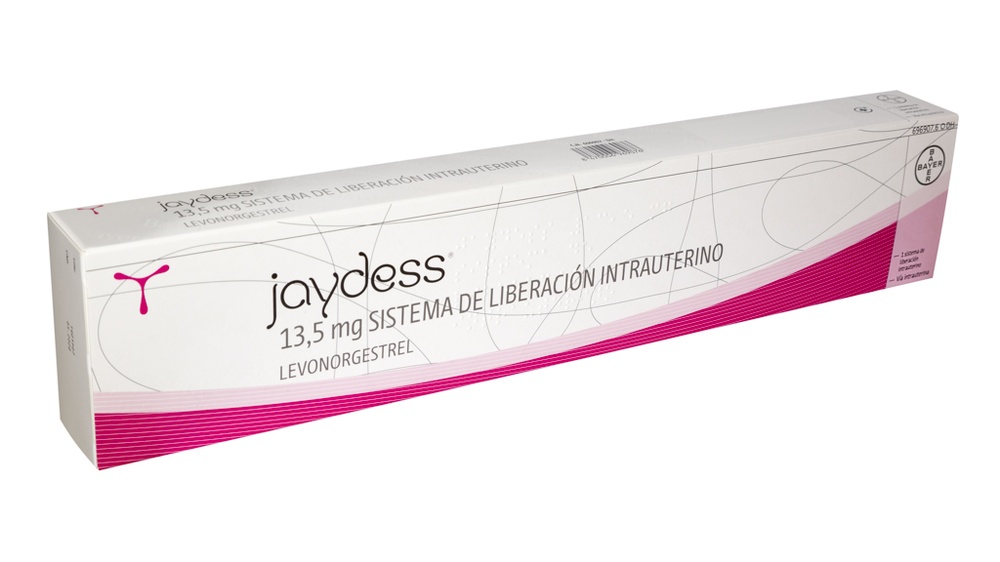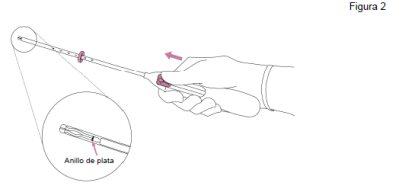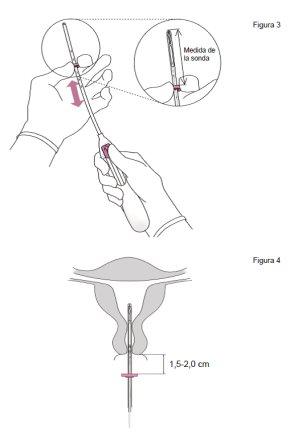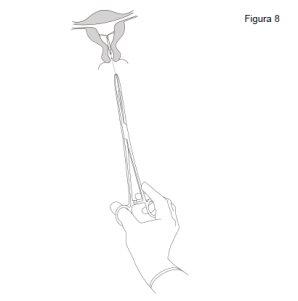

ДЖЕЙДЕСС 13,5 мг ВНУТРИМАТЕРОЧНАЯ СИСТЕМА ПРОЛОНГИРОВАННОГО ВЫСВОБОЖДЕНИЯ


Инструкция по применению ДЖЕЙДЕСС 13,5 мг ВНУТРИМАТЕРОЧНАЯ СИСТЕМА ПРОЛОНГИРОВАННОГО ВЫСВОБОЖДЕНИЯ
Введение
Инструкция: информация для пациентки
Jaydess 13,5мг система внутриматочной доставки
левоноргестрел
?Это лекарство подлежит дополнительному наблюдению, что ускорит обнаружение новой информации о его безопасности. Вы можете способствовать этому, сообщая о побочных эффектах, которые у вас могут возникнуть. В конце раздела 4 содержится информация о том, как сообщать о этих побочных эффектах.
Прочитайте внимательно всю инструкцию перед началом использования этого лекарства, поскольку она содержит важную информацию для вас.
- Сохраните эту инструкцию, поскольку вам может потребоваться прочитать ее снова.
- Если у вас есть какие-либо вопросы, проконсультируйтесь с вашим врачом или медсестрой.
- Это лекарство было назначено только вам, и не передавайте его другим людям, даже если у них такие же симптомы, как у вас, поскольку это может нанести им вред.
- Если вы испытываете побочные эффекты, проконсультируйтесь с вашим врачом или медсестрой, даже если это побочные эффекты, которые не указаны в этой инструкции. См. раздел 4.
Содержание инструкции
- Что такое Jaydess и для чего он используется
- Что вам нужно знать перед началом использования Jaydess
- Как использовать Jaydess
- Возможные побочные эффекты
- Хранение Jaydess
- Содержание упаковки и дополнительная информация
1. Что такое Jaydess и для чего он используется
Jaydess используется для предотвращения беременности (контрацепции) с продолжительностью до трех лет.
Jaydess является системой внутриматочной доставки (СВД) в форме буквы Т, которая после введения внутрь матки медленно выделяет небольшое количество гормона левоноргестрел.
Jaydess работает, уменьшая рост месячного слоя матки и утолщая шейную слизь. Эти действия предотвращают контакт спермы и яйцеклетки и, таким образом, предотвращают оплодотворение яйцеклетки спермой.
2. Что вам нужно знать перед началом использования Jaydess
Общие соображенияПрежде чем начать использовать Jaydess, ваш врач задаст вам некоторые вопросы о вашей личной медицинской истории. В этой инструкции описаны различные ситуации, в которых Jaydess должен быть удален или в которых надежность Jaydess может снизиться. В таких ситуациях вы не должны вступать в половые контакты или должны использовать презерватив или другой барьерный метод. Jaydess, как и другие гормональные контрацептивы, не защищает от заражения ВИЧ (СПИД) или других заболеваний, передающихся половым путем. Jaydess не подходит для использования в качестве экстренного контрацептива (послекоитального контрацептива). |
Не используйте Jaydess
- если вы беременны (см. раздел "Беременность, лактация и фертильность")
- если у вас сейчас есть воспалительное заболевание тазовых органов (ВЗТО; инфекция женских репродуктивных органов) или если вы имели это заболевание несколько раз в прошлом
- если у вас есть состояния, связанные с повышенной склонностью к заболеваниям тазовых органов
- если у вас есть инфекция нижних половых путей (инфекция влагалища или шейки матки)
- если у вас была инфекция матки после родов или после аборта в течение последних 3 месяцев
- если у вас сейчас есть аномалии клеток шейки матки
- если у вас есть или подозревается рак шейки матки или матки
- если у вас есть опухоли, чувствительные к гормонам прогестагенов для роста, например, рак молочной железы
- если у вас есть маточное кровотечение неизвестной причины
- если у вас есть аномалия шейки матки или матки, включая миому, деформирующую полость матки
- если у вас есть активные заболевания печени или опухоль печени
- если вы аллергичны к левоноргестрелу или любому другому компоненту этого лекарства (перечисленному в разделе 6).
Предостережения и меры предосторожности
Прежде чем использовать Jaydess, сообщите вашему врачу, если:
- у вас есть диабет. Обычно нет необходимости изменять ваше антидиабетическое лечение во время использования Jaydess, но ваш врач может захотеть проверить это
- у вас есть эпилепсия. Во время введения или удаления может произойти приступ (криз)
- у вас был в прошлом внематочная беременность или экстラутеринная беременность (беременность вне матки).
Также поговорите с вашим врачом, если у вас есть какие-либо из следующих ситуаций до использования Jaydess или если они появляются впервые во время использования этого лекарства:
- мигрень с нарушениями зрения или другими симптомами, которые могут быть признаками транзиторной ишемии мозга (временного нарушения кровоснабжения мозга)
- исключительно сильная головная боль
- желтуха (желтый цвет кожи, белого глаза и/или ногтей)
- значительное повышение артериального давления
- тяжелые заболевания артерий, такие как инсульт или сердечный приступ.
Следующие признаки и симптомы могут указывать на то, что у вас может быть внематочная беременность, и вы должны немедленно проконсультироваться с вашим врачом (см. также раздел "Беременность, лактация и фертильность"):
- ваш менструальный цикл прекратился, и затем у вас появился постоянный кровотечение или боль
- у вас сильная или постоянная боль в нижней части живота
- у вас есть нормальные признаки беременности, но также у вас есть кровотечение и вы чувствуете себя плохо
- у вас положительный тест на беременность.
Свяжитесь с вашим врачом немедленно, если у вас出现ит любая из следующих ситуаций (см. также раздел 4) и помните, что вы должны сообщить ему, что у вас введен Jaydess, особенно если это не тот человек, который его ввел:
- сильная боль (например, менструальные спазмы) или обильное кровотечение после введения или если вы испытываете боль/кровотечение, которое продолжается более нескольких недель. Это может быть, например, признаком инфекции, перфорации или того, что Jaydess не находится в правильном положении.
- вы больше не чувствуете нити в вашей вагине. Это может быть признаком вытолкнувшегося или перфорированного Jaydess. Вы можете проверить это, осторожно введя палец в вашу вагину и почувствовав нити в конце вашей вагины, gần шейкой матки. Не тяните за нити, поскольку вы можете случайно удалить Jaydess. Используйте барьерный метод (например, презервативы) до тех пор, пока ваш врач не проверит, что СВД все еще находится в правильном положении.
- вы или ваш партнер можете чувствовать нижнюю часть Jaydess. Избегайте половых контактов до тех пор, пока ваш врач не проверит, что СВД все еще находится в правильном положении.
- ваш партнер чувствует нити во время полового контакта.
- вы думаете, что можете быть беременной.
- у вас постоянная боль в животе, лихорадка или необычный вагинальный выделение, что может быть признаком инфекции. Инфекции должны быть немедленно лечены.
- вы чувствуете боль или дискомфорт во время половых контактов, что может быть, например, признаком инфекции, кисты яичника или того, что Jaydess не находится в правильном положении.
- у вас произошли внезапные изменения в вашем менструальном цикле (например, если у вас был скудный или отсутствующий менструальный цикл, и затем у вас появилось постоянное кровотечение или боль), что может быть признаком того, что Jaydess не находится в правильном положении или был вытолкнут.
Рекомендуется использовать прокладки. Если вы используете тампоны или менструальные чашки, вы должны менять их осторожно, чтобы не потянуть за нити Jaydess. Если вы думаете, что могли переместить Jaydess из его положения (см. список выше, чтобы узнать возможные признаки), избегайте половых контактов или используйте барьерный метод (например, презервативы), и свяжитесь с вашим врачом.
Психические расстройства
Некоторые женщины, использующие гормональные контрацептивы, такие как Jaydess, сообщали о депрессии или депрессивном состоянии. Депрессия может быть тяжелой и иногда может вызывать суицидальные мысли.
Если вы испытываете изменения настроения и депрессивные симптомы, свяжитесь с вашим врачом для получения дополнительных медицинских рекомендаций как можно скорее.
Дети и подростки
Jaydess не показан для использования до первого менструального цикла (менархе).
Другие лекарства и Jaydess
Сообщите вашему врачу, если вы принимаете, недавно принимали или можете принимать любое другое лекарство.
Беременность, лактация и фертильность
Беременность
Jaydess не должен использоваться во время беременности.
У некоторых женщин может прекратиться менструальный цикл во время использования Jaydess. Отсутствие менструального цикла не обязательно является признаком беременности. Если у вас нет менструального цикла и у вас есть другие симптомы беременности, вы должны обратиться к вашему врачу для осмотра и теста на беременность.
Если у вас нет менструального цикла в течение шести недель и вы обеспокоены, рассмотрите возможность проведения теста на беременность. Если он отрицательный, нет необходимости проводить другой тест, если у вас нет других признаков беременности.
Если вы забеременеете с введенным Jaydess, вы должны немедленно обратиться к вашему врачу для удаления Jaydess. Удаление может вызвать аборт. Однако, если Jaydess остается на месте во время беременности, не только увеличивается риск спонтанного аборта, но и риск преждевременных родов. Если Jaydess не может быть удален, проконсультируйтесь с вашим врачом о преимуществах и рисках продолжения беременности. Если беременность продолжается, вы будете находиться под близким наблюдением во время беременности и должны немедленно обратиться к вашему врачу, если у вас出现ятся схватки в животе, боль в животе или лихорадка.
Jaydess содержит гормон, называемый левоноргестрелом, и были сообщения о случаях воздействия на гениталии девочек, если они подвергались воздействию внутриматочных устройств с левоноргестрелом, находясь в матке.
Если вы хотите забеременеть, вы должны обратиться к вашему врачу для удаления Jaydess.
Внематочная беременность (беременность вне матки)
Редко бывает, что женщина забеременеет во время использования Jaydess. Однако, если вы забеременеете во время использования Jaydess, увеличивается риск того, что беременность произойдет вне матки (внематочная беременность или эктопическая беременность). Женщины, которые уже имели внематочную беременность, операцию на фаллопиевых трубах или воспалительное заболевание тазовых органов, находятся в группе повышенного риска такой беременности. Внематочная беременность является тяжелым состоянием, требующим немедленной медицинской помощи (см. раздел 2 "Предостережения и меры предосторожности" для признаков и симптомов) и может повлиять на будущую фертильность.
Лактация
Вы можете использовать Jaydess во время лактации. Левоноргестрел (активное вещество Jaydess) был обнаружен в небольших количествах в грудном молоке кормящих женщин. Однако не было обнаружено негативных эффектов на рост и развитие ребенка или на количество и качество грудного молока.
Фертильность
Ваша обычная фертильность вернется после удаления Jaydess.
Вождение и использование машин
Влияние Jaydess на способность управлять транспортными средствами и работать с машинами отсутствует.
3. Как использовать Jaydess
- Прежде чем ввести Jaydess, необходимо убедиться, что вы не беременны.
- Jaydess должен быть введен в течение 7 дней с начала менструации. Когда он вводится в эти дни, Jaydess работает с момента введения и предотвратит беременность.
- Если Jaydess не может быть введен в течение 7 дней с начала менструации или если ваш менструальный цикл нерегулярный, то Jaydess может быть введен в любой другой день. В этом случае вы не должны были иметь половые контакты без контрацепции с момента вашего последнего менструального цикла, а также должны иметь отрицательный тест на беременность перед введением. Кроме того, возможно, что Jaydess не предотвратит беременность надежно с момента введения. Следовательно, вы должны использовать барьерный контрацептив (например, презерватив) или воздержаться от вагинальных половых контактов в течение 7 дней после введения Jaydess.
- Jaydess не показан для использования в качестве экстренного контрацептива (послекоитального контрацептива).
Начало использования Jaydess после родов
- Jaydess может быть введен после родов после того, как матка вернулась к нормальному размеру, и не ранее чем через 6 недель после родов (см. раздел 4 "Возможные побочные эффекты - Перфорация").
- См. также "Начало использования Jaydess" выше, чтобы узнать, что еще вам нужно знать в момент введения.
Начало использования Jaydess после аборта
Jaydess может быть введен сразу после аборта, если беременность длилась менее 3 месяцев, при условии, что нет генитальных инфекций. Jaydess будет работать с момента введения.
Замена Jaydess
Jaydess может быть заменен в любой момент менструального цикла на новый Jaydess. Jaydess будет работать с момента введения.
Переход от другого контрацептивного метода (например, комбинированных гормональных контрацептивов, имплантатов)
- Jaydess может быть введен сразу, если можно убедиться, что вы не беременны.
- Если прошло более 7 дней с начала менструального кровотечения, вы должны воздержаться от вагинальных половых контактов или использовать дополнительную контрацепцию в течение 7 дней.
Введение Jaydess
Осмотры вашего врача перед введением могут включать:
- цитологию шейки матки (тест Папаниколау)
- осмотр молочных желез
- другие тесты, например, для исключения инфекций, включая заболевания, передающиеся половым путем, тест на беременность, если необходимо. Ваш врач также проведет гинекологический осмотр, чтобы определить положение и размер матки.
После гинекологического осмотра:
- вводится инструмент, называемый спекулум, в вагину, и шейка матки может быть очищена антисептическим раствором. Затем Jaydess вводится в матку с помощью тонкой и гибкой пластиковой трубки (трубки для введения). Может быть применена местная анестезия на шейке матки перед введением.
- некоторые женщины испытывают головокружение или обморок во время введения или после введения или удаления Jaydess.
- вы можете испытать некоторую боль и кровотечение во время введения или сразу после.
После введения Jaydess ваш врач должен предоставить вам карточку-помощник для пациентки для плановых осмотров. Возьмите эту карточку с собой на каждом осмотре.
Плановый осмотр и когда обратиться к врачу:
Вам следует проверить Jaydess через 4-6 недель после введения, а затем периодически, не менее чем один раз в год. Ваш врач определит частоту и тип осмотров, которые подходят вашему индивидуальному случаю. Возьмите с собой карточку-помощник для пациентки, которую предоставил ваш врач, на каждом осмотре. Кроме того, вы должны обратиться к вашему врачу, если у вас появятся какие-либо из симптомов, описанных в разделе 2 "Предостережения и меры предосторожности".
Удаление Jaydess
Jaydess должен быть удален не позднее чем через три года после начала использования.
Ваш врач может легко удалить Jaydess в любой момент, после чего беременность становится возможной. Некоторые женщины могут чувствовать головокружение или обморок во время или после удаления Jaydess. Вы можете испытать некоторую боль и кровотечение во время удаления Jaydess.
Продолжение контрацепции после удаления
Если вы не хотите забеременеть, Jaydess не должен быть удален после 7-го дня менструального цикла (менструации), если только вы не будете использовать другие методы контрацепции (например, презервативы) не менее 7 дней до удаления СВД.
Если у вас нерегулярные менструации (менструальный цикл) или у вас нет менструации, вы должны использовать барьерный метод контрацепции в течение 7 дней до удаления.
Также можно ввести новый Jaydess сразу после удаления, в этом случае не требуется дополнительная защита. Если вы не хотите продолжать использовать тот же метод контрацепции, проконсультируйтесь с вашим врачом о других надежных методах контрацепции.
4. Возможные побочные эффекты
Как и все лекарства, Джейдесс может вызывать побочные эффекты, хотя не все люди испытывают их.
Свяжитесь со своим врачом немедленно, если заметите любой из этих симптомов:
- аллергические реакции, включая сыпь, крапивницу (уртикарию) и ангioneдему (характеризующийся внезапным отеком глаз, рта и горла, например).
Также ознакомьтесь с разделом 2, чтобы узнать, когда следует немедленно связаться со своим врачом.
Ниже представлен список возможных побочных эффектов в зависимости от их частоты:
Очень частые побочные эффекты:могут поражать более 1 из 10 человек
- головная боль
- абдоминальная/пельвиная боль
- акне/жирная кожа
- изменения менструального цикла, включая увеличение или уменьшение менструального кровотечения, мазание, нерегулярные периоды и отсутствие кровотечения (см. также следующий раздел о нерегулярном и редком кровотечении)
- овариальный киста (см. также следующий раздел об овариальных кистах)
- вагинит и вульвовагинит
Частые побочные эффекты:могут поражать до 1 из 10 человек
- депрессивное состояние/депрессия
- уменьшение либидо
- мигрень
- тошнота
- потеря волос
- инфекция генитального тракта
- болезненные менструации
- боль/дискомфорт в молочных железах
- вытождение устройства (полное и частичное); (см. следующий раздел о вытождении)
- генитальный дисcharge
- прибавка в весе
Редкие побочные эффекты:могут поражать до 1 из 100 человек
- головокружение
- избыточный рост волос на теле
- перфорация матки (см. также следующий раздел о перфорации)
Описание выбранных побочных эффектов:
Нерегулярное или редкое кровотечение
Вероятно, что Джейдесс повлияет на ваш менструальный цикл. Он может изменить ваши менструальные периоды так, что у вас будет мазание (небольшое количество кровотечения), более длинные или более короткие периоды, более обильное или скудное кровотечение или полное отсутствие кровотечения.
Вы можете испытывать кровотечение и мазание между менструальными периодами, особенно в течение первых 3-6 месяцев. Иногда кровотечение более обильное, чем обычно, в начале.
В целом, вероятно, что вы испытаете постепенное уменьшение количества и продолжительности кровотечения каждый месяц. Некоторые женщины в конечном итоге обнаруживают, что их менструация полностью прекращается.
Возможно, что не произойдет ежемесячного утолщения слизистой оболочки матки из-за влияния гормона, и поэтому нет ничего, что может быть выделено или отторгнуто в виде менструального кровотечения. Это не обязательно означает, что вы достигли менопаузы или что вы беременны. Ваши собственные гормональные уровни обычно остаются нормальными.
Когда устройство удаляется, менструация должна быстро вернуться к норме.
Пельвиная инфекция
Вставной инструмент Джейдесса и само устройство стерильны. Несмотря на это, существует более высокий риск пельвиальной инфекции (инфекций слизистой оболочки матки или фаллопиевых труб) в момент установки и в течение первых 3 недель после установки.
Пельвиальные инфекции у пользователей ВМС обычно связаны с наличием заболеваний, передающихся половым путем. Риск инфекции увеличивается, если у вас или вашего партнера есть несколько половых партнеров или если вы ранее страдали от воспалительного заболевания пельвиальной области (ВЗПО).
Пельвиальные инфекции должны быть немедленно behandены.
Пельвиальные инфекции, такие как ВЗПО, могут иметь серьезные последствия и могут повлиять на фертильность и увеличить риск будущей внематочной беременности (беременности вне матки). В крайне редких случаях может произойти тяжелая инфекция или сепсис (тяжелая инфекция, которая может быть смертельной) вскоре после вставки.
Джейдесс должен быть удален, если вы испытываете повторяющуюся ВЗПО или если инфекция тяжелая или не реагирует на лечение.
Вытождение
Маточные сокращения во время менструации иногда могут вытолкнуть ВМС из положения или вытолкнуть его. Это более вероятно, если у вас есть избыточный вес в момент установки ВМС или если у вас есть история обильных менструаций. Если ВМС сместится с положения, он может не функционировать правильно, и, следовательно, риск беременности увеличивается. Если ВМС вытолкнется, вы больше не защищены от беременности.
Возможные симптомы вытождения - боль и аномальное кровотечение, но Джейдесс также может быть вытолкнут без вашего ведома. Поскольку Джейдесс уменьшает менструальное кровотечение, увеличение кровотечения может быть указанием на вытождение.
Рекомендуется, чтобы вы проверяли нити пальцами, например, во время душа. См. также раздел 2, "Предостережения и меры предосторожности", чтобы узнать, как проверить, находится ли Джейдесс в положении. Если вы заметите признаки, указывающие на вытождение, или не сможете прощупать нити, вам следует использовать дополнительный метод контрацепции (например, презерватив) и проконсультироваться со своим медицинским специалистом.
Перфорация
Во время установки Джейдесса может произойти проникновение или перфорация маточной стенки, хотя перфорация может не быть обнаружена сразу. Если Джейдесс находится вне маточной полости, он неэффективен для предотвращения беременности и должен быть удален как можно скорее. Вам может потребоваться хирургическое вмешательство для удаления Джейдесса. Риск перфорации увеличивается у женщин в период лактации, а также у женщин, которые родили до 36 недель до установки, и может увеличиться у женщин с фиксированным матком, наклоненным назад (матка в ретроверсии и фиксированная). Если вы подозреваете, что могли испытать перфорацию, немедленно обратитесь за медицинской помощью и сообщите, что у вас установлен Джейдесс, особенно если это не был человек, который его установил.
Овариальный киста
Поскольку противозачаточный эффект Джейдесса в основном обусловлен его местным действием на матку, овуляция (выделение яйцеклетки) обычно продолжается во время использования этого лекарства. Иногда может образоваться овариальный киста. В большинстве случаев нет симптомов.
Овариальный киста может потребовать медицинской помощи или, реже, хирургического вмешательства, но обычно проходит самостоятельно.
Сообщение о побочных эффектах
Если вы испытываете любой побочный эффект, проконсультируйтесь со своим врачом, фармацевтом или медсестрой, даже если это возможные побочные эффекты, которые не указаны в этом листке-вкладыше. Вы также можете сообщить о них напрямую через систему испанского фармаковигиланса для лекарств для человека: https://www.notificaram.es. Сообщая о побочных эффектах, вы можете способствовать предоставлению более подробной информации о безопасности этого лекарства.
5. Хранение Джейдесса
Не требует специальных условий хранения.
Храните это лекарство в недоступном для детей месте.
Не открывайте блистер. Только ваш врач или медсестра должны это делать.
Не используйте это лекарство после даты истечения срока годности, указанной на упаковке и блистере после "CAD". Дата истечения срока годности - последний день месяца, указанного.
Лекарства не должны выбрасываться в канализацию или мусор. Поместите упаковку и лекарства, которые вам больше не нужны, в пункт сбора SIGRE  в аптеке. Если у вас есть сомнения, спросите у вашего фармацевта, как избавиться от упаковки и лекарств, которые вам больше не нужны. Таким образом, вы поможете защитить окружающую среду.
в аптеке. Если у вас есть сомнения, спросите у вашего фармацевта, как избавиться от упаковки и лекарств, которые вам больше не нужны. Таким образом, вы поможете защитить окружающую среду.
6. Содержание упаковки и дополнительная информация
Состав Джейдесса
Активное вещество - левоноргестрел. Система внутриматочного выпуска содержит 13,5 мг левоноргестрела.
Другие компоненты:
- эластомер полидиметилсилоксана
- коллоидный безводный диоксид кремния
- полietilen
- сульфат бария
- черный оксид железа (E172)
- серебро
Внешний вид продукта и содержание упаковки
Джейдесс - это система внутриматочного выпуска в форме буквы Т. Вертикальная рука корпуса в форме буквы Т имеет резервуар для лекарства, содержащий левоноргестрел. Есть два нити для удаления, прикрепленные к ручке на нижнем конце вертикальной руки. Кроме того, вертикальная ось имеет серебряное кольцо, расположенное рядом с горизонтальными руками, которое видно при ультразвуковом исследовании.
Размер упаковки:
- 1 x 1 система внутриматочного выпуска.
- 5 x 1 система внутриматочного выпуска.
Возможно, что только некоторые размеры упаковок будут продаваться.
Владелец разрешения на маркетинг
Bayer Hispania, S.L.
Av. Baix Llobregat 3-5
08970 Sant Joan Despí (Barcelona)
Испания
Производитель
Bayer Oy
Pansiontie 47
20210 Turku
Финляндия
Это лекарство разрешено к маркетингу в государствах-членах Европейского экономического пространства и в Великобритании (Северной Ирландии) под следующими названиями:
- Австрия, Бельгия, Чехия, Дания, Финляндия, Франция, Германия, Венгрия, Исландия, Ирландия, Италия, Люксембург, Мальта, Норвегия, Португалия, Румыния, Испания, Швеция: Джейдесс
- Эстония, Латвия, Литва: Флерее
Дата последнего пересмотра этого листка-вкладыша: Май 2024
Другие источники информации
Вы можете получить подробную и актуальную информацию о этом лекарстве, отсканировав код QR, включенный в листок-вкладыш, упаковку и карточку напоминания для пациента, с помощью вашего смартфона. Вы также можете получить доступ к этой информации на следующем сайте: https://cima.aemps.es/info/77169
---------------------------------------------------------------------------------------------------------------------------
Следующая информация предназначена только для медицинских специалистов:
ИНСТРУКЦИИ ПО УСТАНОВКЕ
Джейдесс 13,5 мг система внутриматочного выпуска
Для установки медицинским специалистом с использованием асептической техники.
Джейдесс поставляется в стерильной упаковке, которую не следует открывать до момента установки. Не стерилизуйте повторно. В этой презентации Джейдесс предназначен для одноразового использования. Не используйте, если блистер поврежден или открыт. Не устанавливайте после даты истечения срока годности, указанной на упаковке и блистере после "CAD".
Утилизация неиспользованного лекарства или отходов будет осуществляться в соответствии с местными правилами.
Джейдесс поставляется с карточкой напоминания для пациента в упаковке. Заполните карточку и передайте ее пациенту после установки.
Подготовка к установке
- Осмотрите пациента, чтобы исключить противопоказания для установки Джейдесса (см. Листок-вкладыш, раздел 4.3 и раздел 4.4 под медицинским осмотром).
- Вставьте спекулум, визуализируйте шейку матки и затем тщательно очистите шейку матки и влагалище подходящим антисептическим раствором.
- Используйте помощника, если это необходимо.
- Захватите переднюю губу шейки матки с помощью тенакуля или других щипцов, чтобы стабилизировать матку. Если матка ретровертирован, может быть более подходящим захватить заднюю губу шейки матки. Можно применить легкое напряжение с помощью щипцов, чтобы выровнять шейку матки. Щипцы должны оставаться на месте, и следует применить легкое противонаправленное напряжение на шейку матки во время всей процедуры установки.
- Вставьте маточную сондю в шейку матки до дна матки, чтобы измерить глубину и подтвердить направление маточной полости и исключить любую возможность аномалии внутри матки (например, перегородки, субмукозных миом) или присутствия ранее вставленного внутриматочного контрацептива, который не был удален. Если возникают трудности, рассмотрите возможность расширения шейки матки. Если необходимо расширение шейки матки, оцените использование обезболивающих препаратов и/или парацервикального блокада.
Установка
- Сначала полностью откройте стерильную упаковку. Затем используйте асептическую технику и стерильные перчатки.
|
|
ВАЖНО!Не тяните за рычаг вниз, поскольку это может привести к преждевременному выпуску Джейдесса. Как только он выпущен, Джейдесс нельзя загрузить снова.
|
|
ВАЖНО!Не заставляйте аппликатор. Расширьте шейку матки, если необходимо. |
|
|
|
|
ВАЖНО!Если вы подозреваете, что система не находится в правильном положении, проверьте ее местоположение (например, с помощью ультразвука). Удалите систему, если она не правильно размещена внутри маточной полости. Не следует повторно устанавливать удаленную систему.
Удаление/замена
Для получения информации об удалении/замене см. листок-вкладыш Джейдесса.
Джейдесс удаляется, осторожно вытащив нити с помощью щипцов. Можно сразу же вставить новый Джейдесс после удаления. После удаления Джейдесса необходимо осмотреть систему, чтобы убедиться, что она целая и что она была удалена полностью. |
|
Национальное включение кода QR, который направляет на листок-вкладыш
Листок-вкладыш Джейдесса доступен на сайте https://cima.aemps.es/info/77169
- Страна регистрации
- Активное вещество
- Требуется рецептДа
- Производитель
- Информация носит справочный характер и не является медицинской рекомендацией. Перед приемом любых препаратов проконсультируйтесь с врачом. Oladoctor не несет ответственности за медицинские решения, принятые на основе этого контента.
- Аналоги ДЖЕЙДЕСС 13,5 мг ВНУТРИМАТЕРОЧНАЯ СИСТЕМА ПРОЛОНГИРОВАННОГО ВЫСВОБОЖДЕНИЯФорма выпуска: ВНУТРИМАТОЧНАЯ СПИРАЛЬ, 19,5 мгАктивное вещество: plastic IUD with progestogenПроизводитель: Bayer Hispania S.L.Требуется рецептФорма выпуска: ВНУТРИМАТОЧНАЯ СПИРАЛЬ, 52 мг / начальная скорость высвобождения 0,02 мг каждые 24 часаАктивное вещество: plastic IUD with progestogenПроизводитель: Gedeon Richter Plc.Требуется рецептФорма выпуска: ВНУТРИМАТОЧНАЯ СПИРАЛЬ, 0,02 мг/24 чАктивное вещество: plastic IUD with progestogenПроизводитель: Gedeon Richter Plc.Требуется рецепт
Аналоги ДЖЕЙДЕСС 13,5 мг ВНУТРИМАТЕРОЧНАЯ СИСТЕМА ПРОЛОНГИРОВАННОГО ВЫСВОБОЖДЕНИЯ в других странах
Лучшие аналоги с тем же действующим веществом и терапевтическим эффектом.
Аналог ДЖЕЙДЕСС 13,5 мг ВНУТРИМАТЕРОЧНАЯ СИСТЕМА ПРОЛОНГИРОВАННОГО ВЫСВОБОЖДЕНИЯ в Poland
Аналог ДЖЕЙДЕСС 13,5 мг ВНУТРИМАТЕРОЧНАЯ СИСТЕМА ПРОЛОНГИРОВАННОГО ВЫСВОБОЖДЕНИЯ в Ukraine
Врачи онлайн по ДЖЕЙДЕСС 13,5 мг ВНУТРИМАТЕРОЧНАЯ СИСТЕМА ПРОЛОНГИРОВАННОГО ВЫСВОБОЖДЕНИЯ
Консультация по дозировке, побочным эффектам, взаимодействиям, противопоказаниям и продлению рецепта на ДЖЕЙДЕСС 13,5 мг ВНУТРИМАТЕРОЧНАЯ СИСТЕМА ПРОЛОНГИРОВАННОГО ВЫСВОБОЖДЕНИЯ – по решению врача и с учетом местных правил.










